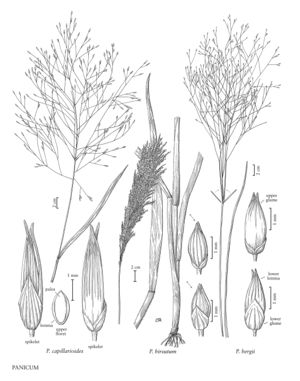Panicum hirsutum
Plants perennial; forming large clumps from short rhizomes. Culms 100-300 cm tall, 4-10 mm thick, decumbent, semi-woody at the base, simple or branching from the middle nodes, prophylls prominent, to 15 cm; nodes contracted, pilose, sericeous; internodes glabrous or with papillose-based hairs below the nodes. Sheaths shorter or longer than the internodes, rounded, sparsely hispid, hairs papillose-based, thick, fragile, penetrating and irritating the skin when handled, margins glabrous or ciliate; collars more densely pubescent than the sheaths, hairs papillose-based; ligules 1.5-2 mm, with longer hairs immediately behind, growing from the base of the blades; blades 20-50 cm long, 15-40 mm wide, spreading, flat or with involute margins, bases subcordate to cordate, margins glabrous or sparsely hairy. Panicles terminal, 25-45 cm long, 5-15 cm wide, lax, contracted to diffuse, not breaking at the base and becoming tumbleweeds, all or most secondary branches confined to the distal 1/3; lower branches whorled; pedicels 0.5-2 mm, appressed. Spikelets 1.8-2.5 mm long, 0.5-1 mm wide, narrowly ellipsoid, glabrous. Lower glumes 0.7-1.4 mm, about 1/2 as long as the spikelets, 3-5-veined, acute to attenuate; upper glumes and lower lemmas subequal, about as long as the spikelets, 7-11-veined; lower florets sterile; lower paleas 1.3-1.7 mm; upper florets 1.2-1.6 mm long, 0.5-0.7 mm wide, glabrous, smooth, shiny, chestnut brown to dark brown. 2n = 36.
Distribution
Tex.
Discussion
Panicum hirsutum grows along river banks or in ditches, often among shrubs in partial shade. Its range extends from southern Texas through eastern Mexico, Central America, Cuba, and the West Indies to Ecuador, Brazil, and Argentina.
Selected References
None.
